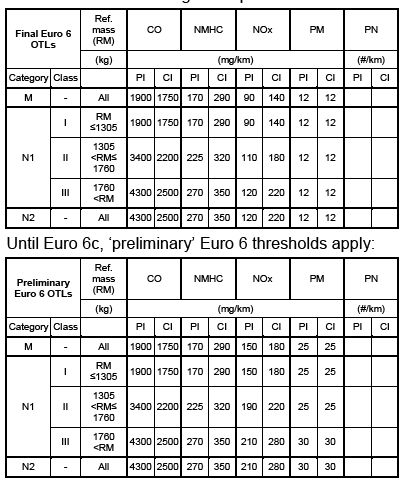
Regulation on Euro 6 Particle Number Limits for DI PI Engines published
The Regulation on Euro 6 Particle Number limits for Direct Injection (DI) Positive Ignition (PI) engines has been published in the EUís Official Journal as Commission Regulation (EU) No. 459/2012. The Regulation also covers the final OBD limits for Euro 6.
As had been expected, the Regulation sets the Euro 6 Particle Number limit for DI PI vehicles at 6.0◊1011 particles/km (the same as for CI engined vehicles), but at the choice of the manufacturer, a limit of 6.0◊1012 particles/km can be applied until 3 years after the start of Euro 6. The full (6.0◊1011/km) limit number, now defined as Euro 6c, thus applies:
- for new types: from 1 September 2017 for M1 and N1 class I vehicles, or from 1 September 2018 for N1 classes II and III.
- for all registrations, sale or entry into service: from 1 September 2018 for M1 and N1 class I vehicles, or from 1 September 2019 for N1 classes II and III.
The Recitals (preamble) to the Regulation note that the PMP procedure may eventually need to be revised for PI engined vehicles because "evidence exists that the size spectra and chemical compositions of particle emissions of positive ignition can differ from those of diesel vehicles".
The Recitals also say that "Gasoline Particle Filters (GPF), an effective aftertreatment technology for abating particles emitted by positive ignition vehicles, are expected to become available for integration into some Euro 6 vehicles at a reasonable cost. In addition, it appears likely that within a time frame of three years after the mandatory Euro 6 dates set out in Article 10 of Regulation (EC) No 715/2007, a similar reduction of PN emissions can be achieved with internal engine measures at substantially lower costs for many applications. Any engine measure must be applicable to all engine working conditions to ensure that, in the absence of aftertreatment devices, emission levels in real life driving conditions are not worsened." Further paragraphs in the Recitals say that attention has to be given to the real driving particle emissions of PI vehicles and the Commission shall introduce a measurement procedure at the latest 3 years after entry into force of Euro 6.
The new Regulation also contains further details of the final OBD Thresholds Limits (OTLs) for Euro 6. These are shown in the following table. These final OTLs are subject to review by the Commission by 1 September 2014. Where they appear to be not technically feasible, the limits or application date will be amended, "considering the effects of other new requirements and tests that will be introduced for Euro 6 vehicles". Where the review shows an environmental need as well as technical feasibility and a net monetised benefit, more stringent values would be adopted. This could include OTLs for particle numbers or additional regulated pollutants.

Particulate filters, oxidation catalysts and NOx aftertreatment systems fitted to CI engines have to be monitored for total failure or removal if it results in emissions limits being exceeded. If NOx sensors are used, the manufacturer has to demonstrate that their use results in the activation of the driver warning system and the driver inducement system:
- if NOx emissions exceed the limit ◊ 1.5 for vehicles approved to Euro 5.
- if the applicable NOx OBD threshold limit is exceeded for vehicles approved to Euro 6. NOx emissions during this demonstration test must be no more than 20% higher than these values.